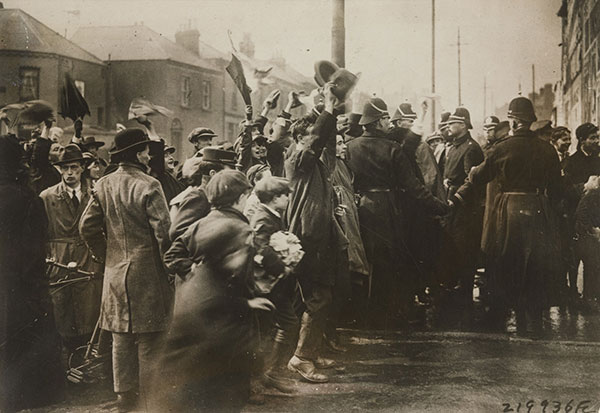100 YEARS AGO: Force-feeding of prisoners and hunger strikes
Published in Issue 1 (January/February 2018), Volume 26By Joseph E.A. Connell Jr
Fasting as a means of coercion was an ancient tradition in Ireland. Irish nationalism renewed interest in the Gaelic past, and W.B. Yeats in The King’s Threshold dramatised the tradition of fasting. The significance of this cultural inheritance is unclear. What is certain is that Irish republicans borrowed the technique of hunger-striking—in prison—from the women’s suffrage movement. Hundreds of women (and some men) in the UK went on hunger strike from 1909 to 1914, though none died.

Above: Crowds outside Mountjoy Jail cheering news of the granting of political status to the 104 republican hunger-strikers within in April 1920. (New York Times)
Between 1913 and 1922 there were approximately 1,000 hunger strikes, with at least seven people dying as a direct result, and more from health complications later on. Counting multiple hunger strikes by the same individual, c. 10,000 Irish republican prisoners went on hunger strike. Irish republicans began hunger-striking after the Easter Rising, when 2,000–3,000 were interned in England and Wales. In 1916 there was a handful of hunger strikes, contesting punishments imposed by the prison authorities. The technique was adopted in earnest in 1917.
Forty prisoners on hunger strike in Mountjoy Jail were forcibly fed, and this procedure led to the death of Thomas Ashe in October 1917. Over the next two and a half years, hundreds of prisoners went on hunger strike; almost all gained concessions, often release. This had two important consequences for the course of the conflict. First, the technique effectively destroyed the British policy of mass internment. Second, the release of prisoners demoralised the armed forces, and so contributed to an outbreak of extra-judicial killings and destruction that further escalated the war.
In autumn 1920, at the height of the War of Independence, the British withdrew political status, which had been won after a two-week mass hunger strike in Mountjoy Jail in April 1920. On 11 August 1920 a mass strike was once again initiated, this time in Cork Jail, when 60 IRA members, most of whom were being held without charge or trial, demanded reinstatement of political status and release. When twelve prisoners from Cork went on hunger strike, the British government refused to concede. Having hardened their attitude against political status after the April strikes, they opted to risk the deaths of prisoners rather than make concessions. In the weeks that followed, the British released or transferred many of the 60 until only eleven were left. On 16 August, Cork Lord Mayor Terence MacSwiney was sentenced to two years but said that his strike would continue, and he was deported to Brixton that very night. Following MacSwiney’s death in October after 74 days on strike, along with the deaths of Michael Fitzgerald and Joseph Murphy, the hunger strike in Cork Jail continued for a further three weeks. Following a request from Arthur Griffith, acting president of the Irish Republic, the remaining nine prisoners ended their fast on 12 November 1920, ending the use of the technique in the War of Independence.
While republican prisoners took their inspiration for hunger strikes from the suffragettes of the early twentieth century, few women were imprisoned during the War of Independence. Many, however, were locked up during the Civil War and started hunger strikes for political status in all the prisons in which they were held. As many as 96 women went on strike in Kilmainham Jail in March 1923, and others in Mountjoy. Apart from the ‘riot’ on the transfer of women from Kilmainham to the North Dublin Union on 30 April 1923, the hunger strikes were probably the most harrowing episodes of the women’s imprisonment, and certainly had the longest-lasting effects.
Joseph E.A. Connell is the author of Michael Collins: Dublin 1916–22 (Wordwell Books).
















